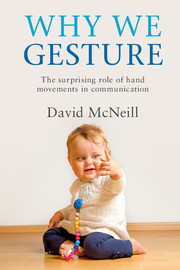Book contents
- Frontmatter
- Dedication
- Contents
- List of figures
- List of tables
- Preface
- Acknowledgments
- Part I Gesture-orchestrated speech
- 1 Why we gesture
- 2 The growth point
- 3 New forms of human action
- 4 Orchestration and unpacking
- 5 Mimicry and metaphor
- Part II Phylogenesis, ontogenesis, brain
- Part III The last page
- References
- Index
1 - Why we gesture
from Part I - Gesture-orchestrated speech
Published online by Cambridge University Press: 05 December 2015
- Frontmatter
- Dedication
- Contents
- List of figures
- List of tables
- Preface
- Acknowledgments
- Part I Gesture-orchestrated speech
- 1 Why we gesture
- 2 The growth point
- 3 New forms of human action
- 4 Orchestration and unpacking
- 5 Mimicry and metaphor
- Part II Phylogenesis, ontogenesis, brain
- Part III The last page
- References
- Index
Summary
Why do we gesture? Many would say it brings emphasis, energy and ornamentation to speech (which is assumed to be the core of what is taking place); in short, gesture is an “add-on.” However, the evidence is against this. The lay view of gesture is that one “talks with one's hands.” You can't find a word, so you resort to gesture. Marianne Gullberg (2013) debunks this ancient idea. As she succinctly puts it, rather than gesture starting when words stop, gesture stops as well. So if, contrary to lay belief, we don't “talk with our hands,” why do we gesture? This book offers an answer.
The reasons we gesture are more profound. Language itself is inseparable from gesture. While gestures enhance the material carriers of meaning, the core is gesture and speech together. They are bound more tightly than saying the gesture is an “add-on” or “ornament” implies. They are united as a matter of thought itself. Even if, for some reason, the hands are restrained and a gesture is not externalized, the imagery it embodies can still be present, hidden but integrated with speech (and may surface in some other part of the body, the feet for example).
As stated in the Preface, the purpose of the current book is to present the multifaceted hypothesis that to orchestrate speech is why we gesture. Gestures of course do not always occur. This is itself an aspect of gesture; there is a natural variation of gesture occurrence. Apart from forced suppressions (as in formal contexts), gestures fall on an elaboration continuum, their position an aspect of the gesture itself. The degree of elaboration is the extent to which the gesture adds communicative “push” to the utterance, what Firbas (1971) called “communicative dynamism.” At one end, very elaborate gestures participate at the highest levels of communicative dynamism; at the other end, where communicative dynamism or “push” is minimal, elaboration reaches zero, ending with no motion at all; yet this is not a disappearance of the gesture and its imagery; it is the minimum of its concrete enactment. The reality is imagery with speech ranging over the entire continuum. It is visuoactional imagery, not a photo. Gesture imagery linked to speech is what natural selection chose, acting on gesture–speech units free to vary in elaboration.
- Type
- Chapter
- Information
- Why We GestureThe Surprising Role of Hand Movements in Communication, pp. 3 - 20Publisher: Cambridge University PressPrint publication year: 2015



